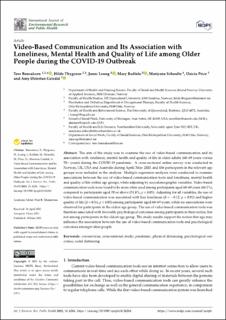| dc.contributor.author | Bonsaksen, Tore | |
| dc.contributor.author | Thygesen, Hilde | |
| dc.contributor.author | Leung, Janni | |
| dc.contributor.author | Ruffolo, Mary | |
| dc.contributor.author | Schoultz, Mariyana | |
| dc.contributor.author | Price, Daicia | |
| dc.contributor.author | Geirdal, Amy Østertun | |
| dc.date.accessioned | 2021-06-28T10:28:47Z | |
| dc.date.available | 2021-06-28T10:28:47Z | |
| dc.date.created | 2021-06-09T13:33:16Z | |
| dc.date.issued | 2021-06-10 | |
| dc.identifier.citation | International Journal of Environmental Research and Public Health. 2021, 18 (12), 1-10). | en_US |
| dc.identifier.issn | 1661-7827 | |
| dc.identifier.uri | https://hdl.handle.net/11250/2761584 | |
| dc.description.abstract | The aim of the study was to examine the use of video-based communication and its association with loneliness, mental health and quality of life in older adults (60–69 years versus 70+ years) during the COVID-19 pandemic. A cross-sectional online survey was conducted in Norway, UK, USA and Australia during April/May 2020, and 836 participants in the relevant age groups were included in the analysis. Multiple regression analyses were conducted to examine associations between the use of video-based communication tools and loneliness, mental health and quality of life within age groups, while adjusting by sociodemographic variables. Video-based communication tools were found to be more often used among participants aged 60–69 years (60.1%), compared to participants aged 70 or above (51.8%, p < 0.05). Adjusting for all variables, the use of video-based communication was associated with less loneliness (β = −0.12, p < 0.01) and higher quality of life (β = 0.14, p < 0.01) among participants aged 60–69 years, while no associations were observed for participants in the oldest age group. The use of video-based communication tools was therefore associated with favorable psychological outcomes among participants in their sixties, but not among participants in the oldest age group. The study results support the notion that age may influence the association between the use of video-based communication tools and psychological outcomes amongst older people. | en_US |
| dc.language.iso | eng | en_US |
| dc.publisher | MDPI | en_US |
| dc.relation.ispartofseries | International Journal of Environmental Research and Public Health;volume 18, issue 12 | |
| dc.rights | Navngivelse 4.0 Internasjonal | * |
| dc.rights.uri | http://creativecommons.org/licenses/by/4.0/deed.no | * |
| dc.subject | Coronavirus | en_US |
| dc.subject | Cross-national studies | en_US |
| dc.subject | Pandemic | en_US |
| dc.subject | Physical distancing | en_US |
| dc.subject | Psychological outcomes | en_US |
| dc.subject | Social distancing | en_US |
| dc.title | Video-based communication and its association with loneliness, mental health and quality of life among older people during the COVID-19 outbreak | en_US |
| dc.type | Peer reviewed | en_US |
| dc.type | Journal article | en_US |
| dc.description.version | publishedVersion | en_US |
| dc.rights.holder | © 2021 by the authors. | en_US |
| dc.source.articlenumber | 6284 | en_US |
| cristin.ispublished | false | |
| cristin.fulltext | original | |
| cristin.qualitycode | 1 | |
| dc.identifier.doi | https://doi.org/10.3390/ijerph18126284 | |
| dc.identifier.cristin | 1914830 | |
| dc.source.journal | International Journal of Environmental Research and Public Health | en_US |
| dc.source.volume | 18 | en_US |
| dc.source.issue | 12 | en_US |
| dc.source.pagenumber | 10 | en_US |

